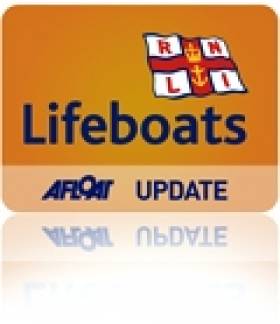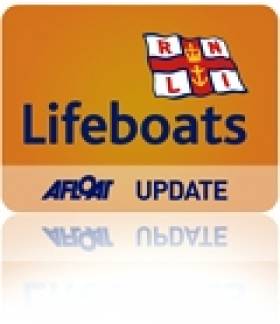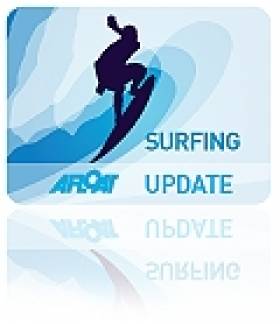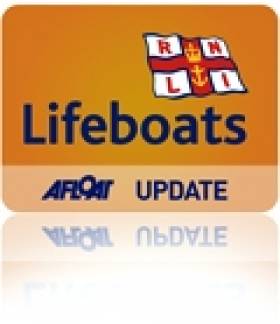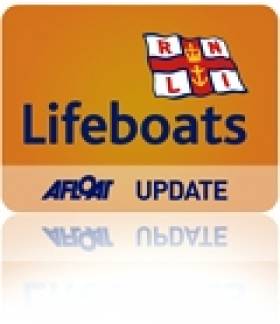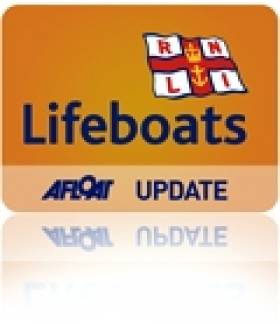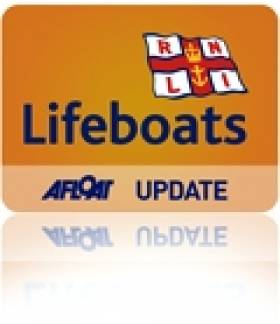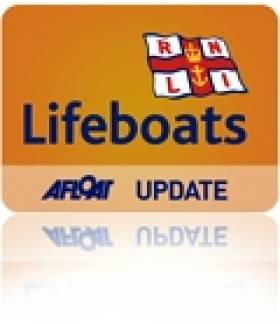Displaying items by tag: Bundoran
Bundoran RNLI Lifeboat Called to Donegal Town
The volunteer crew of Bundoran RNLI were last night requested to launch by Malin Head Coast Guard to reports of a person in the water at the pier in Donegal Town.
Following a 999 call from some passers by, the lifeboat was paged just after 11.45pm and launched around 11:53pm, proceeding to Donegal Town. On arrival on scene at 12:15am the crew commenced a search of the pier area in coordination with the Sligo based Rescue 118 Helicopte, the Killybegs Coast Guard boat, Gardai, Fire Service and HSE Ambulance.
Shortly after 1am, a person was recovered from the water and handed over to the waiting ambulance crew on the pier but was sadly later pronounced dead.
The management and crew of Bundoran RNLI Lifeboat extend sympathies to familiy and friends of the deceased.
Ireland Crowns New Surfing Champions
#Surfing - Only two surfers retained their titles at a delayed Irish Nationals that saw 13 new champions crowned in Bundoran last weekend, as the Irish Examiner reports.
Marginal surf was forecast for the third of three possible windows for the competition, and indeed the contest director stepped in to move the action to Tullan Strand due to inconsistent waves at The Peak early on Saturday 10 October.
It proved a change for the better, providing "tightly fought" surfing action in the men's final especially, as Sligo's Geared McDaid clinched the title from defending champ Stephen Kilfeather.
The women's division also celebrated a new champion in Sophie Pigot of Lahinch's West Coast Surf Club.
The Irish Examiner has much more on the story HERE.
#RNLI - The volunteer crew of Bundoran RNLI were called out on Saturday evening (16 May) to reports of swimmers in trouble near the diving boards in Bundoran.
The emergency call was received by Malin Head Coast Guard just after 7.40pm by a member of the public at the nearby golf course. They immediately requested the launch of the lifeboat as well as tasking the Irish Coast Guard's Sligo-based Rescue 118 Helicopter.
Minutes later, the Bundoran lifeboat was in the water en route to the scene while other volunteer crew members went to the diving boards area by shore.
As there was a heavy swell running, the lifeboat was forced to sit off Roguey as the shore crew gave an update on the casualties from the scene.
The initial 999 caller had used the ring buoy located on the Roguey walk to throw to the two teenagers to assist in their rescue, and by the time the crew had arrived they had made it to safety.
Moments afterwards Rescue 118 arrived on scene, landing on the beach to allow a paramedic to check over the casualties before they were given the all clear.
Speaking on their return to the lifeboat station, volunteer Killian O’Kelly said: "The two lads were very lucky that they were spotted so quickly by the person on the golf course and that the ring buoy was available so close to where the incident happened – otherwise we could have had a very different outcome.
"We would remind swimmers to be mindful of conditions they are setting out into and to passers by if you see anyone in trouble at the coast please dial 999 or 112 immediately."
Bundoran Lifeboat Rescues Teen After Jet Ski Capsize
#RNLI - Bundoran RNLI rescued a teenager who fell from a capsized jet ski on Thursday afternoon (9 April).
The volunteer crew was requested to launch their inshore lifeboat by Malin Head Coast Guard at 1.24pm following a report that a jet ski had capsized a short distance from Bundoran Pier.
The lifeboat, helmed by Daimon Fergus and with crew members James Cassidy and Elliot Kearns on board, launched and made its way to the scene just a couple of hundred yards from the shore. Weather conditions at the time were described as good with the sun shining and the sea flat calm.
On arrival, the crew observed two males, one of whom had managed to get back on to the jet ski and a second who was still in the water.
The lifeboat crew pulled the teenager from the water and brought him back to shore where he was treated for hypothermia and the effects of having swallowed some sea water. He was subsequently transferred to Sligo General Hospital via ambulance as a precautionary measure.
"Thankfully, the lifeboat crew were able to assist this afternoon and bring this young man to safety," said Bundoran RNLI lifeboat operations manager Tony McGowan after the callout.
McGowan also encouraged anyone taking to the water "to enjoy themselves but be mindful that while the sun is shining and the weather is warm, sea temperatures are still very cold and it is important to dress appropriately bearing that in mind."
Bundoran's lifeboat crew were tasked again on Friday night (10 April) to reports of a red flare spotted over Rossnowlagh.
Following a call to Malin Head Coast Guard, the crew were paged just after 9pm and launched a short time later under cover of darkness, arriving at Rossnowlagh just before 9.30pm to commence a search of the area near Smugglers Creek. They were also joined by the Sligo-based Irish Coast Guard helicopter.
The search continued for approximately one hour before both crews were stood down and returned to base having found nothing.
Speaking on their return to the lifeboat station, volunteer helm Elliot Kearns said: "We would class this a false alarm with good intent and the member of the public who made the call was exactly right to call the coastguard. We would always rather be called to something that somebody was unsure about rather than a life be lost."
However, Kearns also urged anyone setting off Chinese lantern or lighting fires near the coast "to call the coastguard in advance to advise them. Of course if you see anyone in trouble at the coast please dial 999 or 112 immediately."
The callout was the third in a week for the Bundoran station, beginning with the rescue of a surfer in difficulty off Tullan Strand on Monday 6 April.
#Surfing - No stranger to lists of the world's top surfing destinations, Bundoran has been cited yet again as a spot no waverider worth their salt will want to miss.
This time the Donegal surfing mecca – set to attract the cream of Europe's surf talent to the Sea Sessions this coming June – is included in All Day's list of 'The Amazing Waves All Surfers Want To Ride'.
"Hardcore surfing enthusiasts don’t let the cold Irish waters stop them from surfing the green waves," says the social news site, which lists Bundoran alongside lesser known sites such as Cloud Nine in the Philippines and Cornwall's Watergate Bay.
Bundoran Lifeboat Launches To Surfer In Difficulty
#Lifeboats - Yesterday evening (Monday 6 April), the volunteer crew of Bundoran RNLI were requested by the Irish Coast Guard at Malin Head to launch to a surfer in difficulty.
Shortly after 8pm, a passer-by noticed a female surfer in difficulty off Tullan Strand in Bundoran and immediately dialled 999.
Moments later the lifeboat crew were paged and within four minutes the Atlantic 85 lifeboat was launched from the pier, arriving on scene in under three minutes.
The crew brought the surfer and her surfboard on to the lifeboat and performed a quick medical check finding she was shaken but uninjured. The crew then returned to the station.
Speaking after their return, lifeboat helm Brian Gillespie said: "We are thankful to the member of the public who did the right thing by calling the coastguard.
"Darkness was beginning to fall and had it been any later the situation may have turned more dangerous. Thankfully the surfer is OK.
"As the weather is getting better, we want people to enjoy themselves but we would urge water users to exercise common sense and heed basic water safety principles.”
Bundoran Lifeboat Crew Named Emergency Response Team Of The Year
#RNLI - The volunteer crew of Bundoran RNLI's lifeboat received the Emergency Response Team of the Year award at a ceremony on Saturday night (24 January).
The 2015 Community and Council Awards celebrated by LAMA (Local Authority Members Association) took place at the Crowne Plaza Hotel in Santry, North Dublin and saw community groups from all over the country recognised for their achievements in the past year.
The lifeboat crew from the popular Donegal surfing haunt, who are celebrating their 40th anniversary, were nominated by Donegal County Councillor Barry O’Neill.
"What this crew do is of upmost importance not just to Bundoran but to the whole region and they are carrying on a legacy for the people who had the vision to establish the service in the first place," he said.
Accepting the award on behalf of the crew at the ceremony, volunteer press officer Shane Smyth, along with senior helm Elliot Kearns, said: "We are thrilled to be here tonight to accept this award for the volunteer crew which is a testament to their commitment to the RNLI ethos of saving lives at sea.
"Each one of our crew, be they on the boat or not, volunteers their time and skills all year round in order to keep our coastline safer and I know they will be delighted with this accolade tonight."
RNLI divisional operations manager Darren Byers added: "This is a great honour for Bundoran RNLI. Every one of our lifeboat stations operates to the highest standards.
"What many people will not know is that behind the big rescues and stories, there is a dedicated group of people who train all year round and who are always ready to drop everything to ensure the lifeboat launches to help those in trouble.
"From the lifeboat crew to the shore crew and station management to the dedicated fundraisers, they all work together on behalf of their community to rescue, to serve, to raise awareness and to educate. Well done to everyone at Bundoran RNLI."
The award came less than a week ahead of the crew’s 40th annual fundraising dinner dance with music from country star Johnny Brady, which takes place at the Great Northern Hotel in Bundoran this Friday 30 January.
Wicklow Lifeboat Assists Fishing Vessel
#RNLI - Wicklow RNLI's all-weather lifeboat launched yesterday morning (Sunday 23 November) to assist a fishing vessel with mechanical problems seven miles north of Wicklow Harbour.
The lifeboat, under the command of second coxswain Ciaran Doyle, located the 10-metre vessel with three fishermen on board shortly after 10am near the Breaches Buoy.
Weather conditions in the area were slight sea with westerly wind force two.
A towline was established and the fishing boat was taken in tow back to Wicklow. The lifeboat arrived back in the harbour at 11.20am and secured the fishing vessel with three crew safely alongside the south quay.
The crew on this callout were Doyle, mechanic Brendan Copeland, Carol Flahive, Kevin Rahill, John Vize, Alan Goucher and Peter McCann.
Elsewhere over weekend, the volunteer crew of Bundoran RNLI lifeboat were launched on Saturday evening (22 November) to reports of a surfer in difficulty at the town's Main Beach.
As darkness was beginning to fall, the crew were paged at 4.06pm by Malin Head Coast Guard and launched within minutes in rough conditions, making their way to beach. But on approach they were advised that the surfer had made his way ashore and were stood down.
Speaking on their return to the station, volunteer crewman Brian Faulkner said: "We are thankful that this is another callout that had a happy ending.
"As we head into the winter, the sea is getting rougher and evenings are getting shorter – conditions can change at a moments notice and we would always urge water users to be mindful of this."
Busy Weekend With Two Callouts For Bundoran Lifeboat
#RNLI - The volunteer crew of the Bundoran RNLI lifeboat were called out twice over the weekend to two different incidents, both of which ended well.
On Saturday afternoon (27 September) just after 1.40pm, the crew received a report that a boat’s propeller had become entangled in the rope of an old lobster pot just off Mountcharles.
Making their way across the bay to the scene, the volunteer crew found that the boat had indeed become entangled and was unable to move.
The experienced skipper had dropped anchor to ensure that the craft was stabilised, which eased the work of the RNLI crewman who went under the boat in order to cut the rope from the propeller.
Within minutes, the thankful skipper was underway and the lifeboat returned the station in Bundoran.
Just after 6pm on Sunday evening (28 September) the pagers sounded again as Malin Head Coast Guard had been alerted to a surfer who was in difficulty in the water at Rossnowlagh.
Within six minutes the lifeboat was in the water and speeding towards the scene with shore crew also tasked to the scene. The Irish Coast Guard's Sligo-based helicopter Rescue 118 was also tasked.
However, as the lifeboat passed Kildoney Point the crew were informed that the surfer was ashore and they were stood down.
The deputy launching authority at Bundoran RNLI commented later: "Thankfully these callouts ended well. We would as usual always remind members of the public that if they see anyone in difficulty on the coast to dial 999 or 112 and ask for the coastguard."
Bundoran Lifeboat Launches To 'Red Flare' Sighting
#RNLI - Bundoran RNLI has urged anyone planning on setting off fireworks or anything similar that could be mistaken for a distress flare to inform the coastguard in advance after a false alarm on Saturday night (6 September).
At 10.40pm the Bundoran volunteer lifeboat crew were asked to launch by Malin Head Coast Guard to reports of a red flare being sighted somewhere in Donegal Bay.
A red flare is universally known as a distress signal, and when an emergency call was made by a member of the public from Ballyshannon, the watch officers at Malin Head immediately requested the launch of Bundoran RNLI, as well as tasking the Killybegs coastguard boat.
As the caller was unsure of the precise location of the flare, sighting it somewhere between Ballyshannon and St John’s Point, both boats commenced searches of the area. looking for a vessel that may have signalled an emergency.
As the searches were underway, information was received that fireworks had been set off on the coastline in the bay around the time of the emergency call to 999.
Even though it was determined that this was the most likely cause of the red flare sighting, both boats continued to search the area until the coastguard was satisfied that no vessel was in trouble. Both units were then stood down after one hour.
Speaking on their return to the lifeboat station around midnight, Karol McNern, who helmed the Bundoran lifeboat, said: "Thankfully this was just a false alarm and we are, as always, happy to launch to something that people may be unsure of rather than not be launched at all.
"We would however urge anybody who is planning on setting off fireworks, Chinese lanterns or anything that could be mistaken for a distress flare, near the coast, to please inform the coastguard in advance of the approximate time and location so that search and rescue assets need not be unnecessarily launched."


























